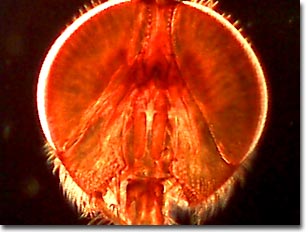Advanced Condenser Systems: Abbe Condensers
House Fly Head
The images below compare performance of the Intel Play QX3 Computer Microscope with and without the aid of an organized cone of illumination from a darkfield Abbe substage condenser containing an aperture diaphragm. These photomicrographs are unretouched and were captured with the QX3 interactive software.
House Fly Head Whole Mount


The often maligned common house fly is generally thought to be a nuisance and vector for many diseases that affect both humans and animals. Flies lay up to 1000 eggs in some of the most undesirable settings such as garbage, decomposing plant and animal matter, feces, spoiled food, and manure. Although more abundant in the warm spring and hot summer weather, house flies may exist year-round in temperate climates, where their life cycles occur every eight days.
House flies are among the speediest of insects with an average speed of about five miles per hour (mph) with bursts to 15 mph when threatened. The rapid beating of their wings (about 1,000 times per second) is responsible for the buzzing noise that accompanies a close fly-by. The sensitive antennae of the fly is responsible for detecting both food sources and changes in air currents which signal the approach of enemies.
The life-span of a typical fly is about 21 days, but they can live much longer in cool weather, although their metabolism and active movement is severely reduced. The average fly is between five to eight millimeters in length and they range from gray to dark brown with dark stripes on the thorax. The abdomen is colored yellow on the sides, and the eyes are often red or green. The mouth forms a fleshy proboscis, which is used to gather food. The larvae are cylindrical white maggots that average about a centimeter in length and taper off at the ends. Puparia are reddish-brown and are about half the size of the larvae.
Semi-transparent insects and mites are difficult to image using unaided brightfield optical microscopy. The images above were recorded using the Intel Play QX3 microscope in transmitted darkfield illumination mode. On the top is a digital image from a stock QX3 microscope using auxiliary illumination provided by a fiber optic light pipe through a hole drilled into the mixing chamber. The image on the bottom was recorded using the QX3 microscope body and a Nikon achromatic substage condenser of low numerical aperture.
BACK TO TRANSMITTED DARKFIELD GALLERY
